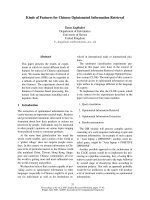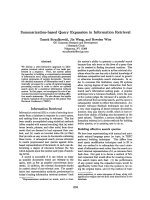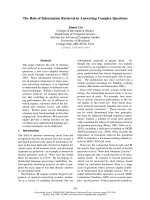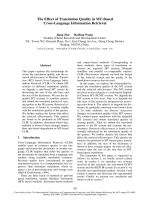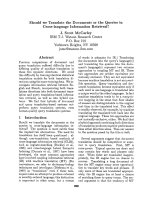Utilizing EEG signal in music information retrieval
Bạn đang xem bản rút gọn của tài liệu. Xem và tải ngay bản đầy đủ của tài liệu tại đây (5.93 MB, 77 trang )
UTILIZING EEG SIGNAL IN MUSIC
INFORMATION RETRIEVAL
ZHAO WEI
B.Sc. OF ENGINEERING
UNIVERSITY OF ELECTRONIC SCIENCE AND TECHNOLOGY OF CHINA
2006
A THESIS SUBMITTED
FOR THE DEGREE OF MASTER OF SCIENCE
DEPARTMENT OF COMPUTER SCIENCE
SCHOOL OF COMPUTING
NATIONAL UNIVERSITY OF SINGAPORE
2010
Abstract
Despite significant progresses in the field of music information retrieval (MIR),
grand challenges such as the intention gap and the semantic gap still exist. Inspired
by the current successes in the Brain Computer Interface (BCI), how to utilize
electroencephalography (EEG) signal to solve the problems of MIR is investigated
in this thesis. Two scenarios are discussed respectively: EEG-based music emotion
annotation and EEG-based domain specific music recommendation. The former
project addresses the problem that how to classify music clips to different emotion
categories based on audiences’ EEG signal when they listen to the music. The
latter project presents an approach to analysis sleep quality from EEG signal as
a component of an EEG-based music recommendation system which recommends
music according to the user’s sleep quality.
i
Acknowledgement
This thesis would not have been possible without the support of many people.
I wish to express my greatest gratitude to my supervisor, Dr. Wang Ye who offered
valuable support and guidance since I started my study in School of Computing. I
also owe my gratitude to Dr. Tan from Singapore General Hospital for her professional suggestions about music therapy, to Ms. Shi Dongxia of National University
Hospital for her generous help in annotating the sleep EEG data.
I would like to thanks Wang Xinxi, Li Bo and Anuja for their assistance and help
in the system implementation of my work. Special thanks also to all participants
involved in the EEG experiments: Ye Ning, Zhang Binjun, Lu Huanhuan, Zhao
Yang, Zhou Yinsheng, Shen Zhijie, Xiang Qiaoliang, Ai Zhongkai, et al.
I am deeply grateful to my beloved families, for their consistent support and endless love. To support my research, my wife even has attached electrodes on her
scalp during sleep for a week.
Without the support of those people, I would not be able to finish this thesis.
Thanks you so much!
ii
Contents
Abstract
i
Acknowledgement
ii
Contents
iii
List of Publications
v
List of Figures
vi
List of Tables
vii
1 Introduction
1.1 Motivation . . . . . . . . . . . . . . . . . . . . . . . . . . . . . . . .
1.2 Organization of the Thesis . . . . . . . . . . . . . . . . . . . . . . .
2 EEG-based Music Emotion Annotation System
2.1 Introduction . . . . . . . . . . . . . . . . . . . . . . . .
2.2 Emotion Recognition in Affective Computing . . . . . .
2.3 Physiology-based Emotion Recognition . . . . . . . . .
2.3.1 General Structure . . . . . . . . . . . . . . . . .
2.3.2 Emotion Induction . . . . . . . . . . . . . . . .
2.3.3 Data Acquisition . . . . . . . . . . . . . . . . .
2.3.4 Feature Extraction and Classification . . . . . .
2.4 A Real-Time Music-evoked Emotion Detection System
2.4.1 Introduction . . . . . . . . . . . . . . . . . . . .
2.4.2 System Architecture . . . . . . . . . . . . . . .
2.4.3 Demonstration . . . . . . . . . . . . . . . . . .
2.5 Current Challenges and Perspective . . . . . . . . . . .
.
.
.
.
.
.
.
.
.
.
.
.
.
.
.
.
.
.
.
.
.
.
.
.
.
.
.
.
.
.
.
.
.
.
.
.
.
.
.
.
.
.
.
.
.
.
.
.
.
.
.
.
.
.
.
.
.
.
.
.
.
.
.
.
.
.
.
.
.
.
.
.
.
.
.
.
.
.
.
.
.
.
.
.
1
1
3
4
4
6
7
8
9
10
14
16
16
18
24
26
3 Automatic Sleep Scoring using EEG Signal-First Step Towards a
Domain Specific Music Recommendation System
29
iii
CONTENTS
3.1
3.2
3.3
3.4
3.5
Introduction . . . . . . . . . . . . . . . .
3.1.1 Music Recommendation according
3.1.2 Normal Sleep Physiology . . . . .
3.1.3 Paper Objectives . . . . . . . . .
3.1.4 Organization of the Thesis . . . .
Literature review . . . . . . . . . . . . .
3.2.1 Manual PSG analysis . . . . . . .
3.2.2 Computerized PSG Analysis . . .
Methodology . . . . . . . . . . . . . . .
3.3.1 Feature Extraction . . . . . . . .
3.3.2 Classification . . . . . . . . . . .
3.3.3 Post Processing . . . . . . . . . .
Experiment Results . . . . . . . . . . . .
Conclusions . . . . . . . . . . . . . . . .
iv
. . . . .
to Sleep
. . . . .
. . . . .
. . . . .
. . . . .
. . . . .
. . . . .
. . . . .
. . . . .
. . . . .
. . . . .
. . . . .
. . . . .
. . . . .
Quality
. . . . .
. . . . .
. . . . .
. . . . .
. . . . .
. . . . .
. . . . .
. . . . .
. . . . .
. . . . .
. . . . .
. . . . .
.
.
.
.
.
.
.
.
.
.
.
.
.
.
.
.
.
.
.
.
.
.
.
.
.
.
.
.
.
.
.
.
.
.
.
.
.
.
.
.
.
.
.
.
.
.
.
.
.
.
.
.
.
.
.
.
.
.
.
.
.
.
.
.
.
.
.
.
.
.
31
32
33
34
35
37
37
37
39
40
41
42
45
50
4 Conclusion and Future work
51
4.1 Content-based Music Similarity Measurement . . . . . . . . . . . . 53
Bibliography
58
List of Publications
Automated Sleep Quality Measurement using EEG signal-First Step
Towards a Domain Specific Music Recommendation System,
Wei Zhao, Xinxi Wang and Ye Wang, ACM Multimedia International Conference
(ACM MM), 25-29th October 2010, Firenze, Italy.
v
List of Figures
2.1
2.2
2.3
2.4
2.5
2.6
2.7
2.8
2.9
2.10
Recognize Musical Emotion from Acoustic Features of Music
Recognize Musical Emotion from Audience’s EEG Signal . .
System Architecture . . . . . . . . . . . . . . . . . . . . . .
Human Nervous System . . . . . . . . . . . . . . . . . . . .
EEG signal Acquisition Experiments . . . . . . . . . . . . .
Physiology-based Music-evoked Emotion Detection System .
Electrode Position in the 10/20 International System . . . .
Feature Extraction and Classification Module . . . . . . . .
Music Game Module . . . . . . . . . . . . . . . . . . . . . .
3D Visualization Module . . . . . . . . . . . . . . . . . . . .
.
.
.
.
.
.
.
.
.
.
.
.
.
.
.
.
.
.
.
.
.
.
.
.
.
.
.
.
.
.
.
.
.
.
.
.
.
.
.
.
5
5
8
12
15
19
21
22
23
25
3.1
3.2
3.3
3.4
3.5
3.6
Physiology-based Music Rating Component . . . . . . .
Typical Sleep Cycles . . . . . . . . . . . . . . . . . . . .
Traditional PSG system with Three Physiological Signals
Band Power Features and Sleep Stages . . . . . . . . . .
Position of Fpz and Cz in the 10/20 System . . . . . . .
Experiment Over the Recording, st7052j0 . . . . . . . . .
.
.
.
.
.
.
.
.
.
.
.
.
.
.
.
.
.
.
.
.
.
.
.
.
32
34
36
41
46
49
4.1
Content-based Music Recommendation Component . . . . . . . . .
54
vi
.
.
.
.
.
.
.
.
.
.
.
.
List of Tables
2.1
2.2
2.3
Targeted Emotion and Associated Stimuli . . . . . . . . . . . . . .
Physiological Signals related to Emotion . . . . . . . . . . . . . . .
Extracted Feature and Classification Algorithm . . . . . . . . . . .
11
14
17
3.1
3.2
3.3
3.4
3.5
3.6
Accuracy of SVM Classifier in 10-fold Cross-validation
Confusion Matrix on st7022j0 . . . . . . . . . . . . . .
Confusion Matrix on st7052j0 . . . . . . . . . . . . . .
Confusion Matrix on st7121j0 . . . . . . . . . . . . . .
Confusion Matrix on st7132j0 . . . . . . . . . . . . . .
Accuracy of SVM and SVM with Post-processing . . .
47
47
47
48
48
48
vii
.
.
.
.
.
.
.
.
.
.
.
.
.
.
.
.
.
.
.
.
.
.
.
.
.
.
.
.
.
.
.
.
.
.
.
.
.
.
.
.
.
.
Chapter 1
Introduction
1.1
Motivation
With the rapid development of digital music industry, music information retrieval
(MIR) has received much attention in last decades. Over years of development,
however, critical problems still remain, such as the intention gap between users
and systems and the semantic gap between low-level features and high-level music
semantics. These problems significantly influence the performance of current MIR
systems.
User feedback plays a important role in Information Retrieval (IR) systems.
It has been presented as an efficient method to improve the performance of IR
system by conducting relevance assessment [1]. This technique is also useful for
MIR systems. Recently, physiological signal was presented to be new approach
1
Chapter 1 Introduction
2
to continuously collects reliable information from users without interrupt towards
them [2]. However, physiological signals have received few attentions in the MIR
community.
For the last two years, I have been conducting research about Electroencephalography (EEG) signal analysis and its applications in MIR. My decision to choose
this topic is also inspired by the successful stories of Brain Computer Interface
(BCI) [3]. Two years ago, I was surprised by the amazing applications of BCI
technology such as P300 speller [4], and motor-imaginary-controlled robot [5], etc.
At that time I came up the idea that utilizing EEG signal in traditional MIR systems. I have been trying to find a scenario where EEG signal can be integrated
in a MIR system. So far two projects have been conducted: EEG-based musical
emotion recognition and EEG-assisted music recommendation system.
The first project is musical emotion recognition from audience’s EEG feedback.
Music emotion recognition is an important but challenging task in music information retrieval. Due to the well-known semantic gap problem, musical emotion
cannot be accurately recognized from the low level features extracted from music
items. Consequently I try to recognize musical emotion from Audience’s EEG signal instead of music item. An online system was built to demonstrate this concept.
Audience’s EEG signal is captured when s/he listens to the music items. Then
Alpha frontal power feature is extracted from EEG signal. A SVM classifier is used
to classify each music items in three musical emotions: happy, sad, and peaceful.
In the second project, an EEG-assisted music recommendation system is proposed. This work addresses a healthcare scenario, music therapy, that utilizing
Chapter 1 Introduction
3
music to heal people who suffer from sleep disorders. Music therapy research has
indicated that music does have beneficial effects on sleep. During the process of
music therapy, people are asked to listen to a list of music, which is pre-selected
by music therapist. In spite of its clear benefits towards sleep quality, current
approach is difficult to be widely used because it is a time consuming task for
music therapist to produce a personalized music list. Based on this observation,
an EEG-assisted music recommendation system was proposed, which automatically recommends music for user according to his sleep quality estimated from
EEG signal. As the first attempt, how to measure sleep quality from EEG signal
is investigated. This work was recently selected for poster presentation in ACM
Multimedia 2010.
1.2
Organization of the Thesis
The thesis is organized as follows. EEG-based Music Emotion Annotation System
is presented in detail in Chapter 2. Chapter 3 discuss the EEG-assisted music recommendation system. Future work and Perspective are summarized in Chapter 4.
Chapter 2
EEG-based Music Emotion
Annotation System
2.1
Introduction
Like genre and culture, emotion is one important factor of music which has attracted much attention in MIR community. Musical emotion recognition is usually
regarded as a classification problem in earlier studies. To recognize the emotion
of one music clip, low-level features are extracted and fed into a classifier which
is trained based on labeled music clips [6], as presented in Figure 2.1. Due to the
semantic gap problem, low-level features, such as MFCC, cannot reliably describe
the high level factors of music. In this chapter I explore an alternative approach
which recognizes music emotion from human’s physiological signal instead of low-
4
Chapter 2 EEG-based Music Emotion Annotation System
5
Figure 2.1: Recognize Musical Emotion from Acoustic Features of Music
Figure 2.2: Recognize Musical Emotion from Audience’s EEG Signal
level feature of music item, as described in Figure 2.2.
A physiology-based music emotion annotation approach is investigated in this
part. The research problem is how to recognize human’s perceptive emotion from
physiology signal while he or she listen to emotional music. As human emotion
detection was first emphasized in the affective computing community [7], we briefly
introduce affective computing in Chapter 2.2. A survey about emotion detection
from physiology signal is given in Chapter 2.3. Our research prototype, a online
music-evoked emotion detection system, is presented in Chapter 2.4. The challenge
and perspective are discussed in Chapter 2.5.
Chapter 2 EEG-based Music Emotion Annotation System
2.2
6
Emotion Recognition in Affective Computing
Emotion is regarded as a complex mental and physiological state associated with a
large amount of feeling and thought. When human communicate with each other,
their behavior considerably depends on their emotion state. Different emotion
states, happy, sad and disgust always influence the decision of human and the
efficiency of the communication. To efficiently cooperate with others, people need
to take account of this subjective factor of human, the emotion. For example, a
salesman talks with many people every day. To promote his product, he has to
adjust his communication strategy in accordance with the respondent emotion of
consumers. The implication is clear to all of us: emotion plays a key role in our
daily communication.
Since human is subject to their emotion states, the efficiency of communication
between human and machine is also affected by the user’s emotion. Obviously it
is beneficial that if the machine can response differently according to the user’s
emotion, as what a salesman has to do. There is no doubt that taking account
of human emotion can considerably improve the performance for human machine
interaction [7, 8, 9]. But so far few emotion-sensitive systems have been built. The
problem behind this is that emotion is generated by the mental activity which is
hidden in our brain. Because of the ambiguous definition of emotion, it is difficult
to recognize emotion fluctuation accurately. Since automated recognition of human
emotion has a big impact and implies a lot of applications in Human Computer
Chapter 2 EEG-based Music Emotion Annotation System
7
Interaction, it has attracted a large body of attention from researcher in computer
science, psychology, and neuroscience.
There are two main approaches to recognize the emotion: Physiology-based
Emotion Recognition and Facial&Vocal-based Emotion Recognition. On
the one hand, some researchers have obtained many results to detect emotion from
facial image, human voice [10]. These face and voice signals, however, depends on
human explicit and deliberately expression of emotion [11]. With the advances
in sensor technology, on the other hand, physiological signal are introduced to
recognize the emotion. Since emotion is results of human intelligence, it is believed
that emotion can be recognized from physiology signal, which is generated by
human nervous system, the source of human Intelligence [12]. In contrast with
face and voice, the main advantage of physiology approach is that emotion can
be analyzed from physiological signal without subject’s deliberately expression of
emotion.
2.3
Physiology-based Emotion Recognition
Current approaches of physiology-based emotion detection are investigated in this
part. As discussed in Chapter 2.3.1, an typical emotion detection system consists
of four components, emotion induction, data acquisition, feature extraction, and
classification. The methods and algorithms employed in these components are
respectively summarized in Chapter 2.3.2, Chapter 2.3.3, and Chapter 2.3.4.
Chapter 2 EEG-based Music Emotion Annotation System
8
Figure 2.3: System Architecture
2.3.1
General Structure
To detect emotion states from physiological signal, the general approach can be
summarized as the answers for four questions as follow:
a. What emotion states are going to be detected?
b. What stimuli are used to evoke the specific emotion states?
c. What physiological signals are collected while the subject obtains the
stimuli?
d. Given the signals, how to extract feature vector and do the classification?
As described in Figure 2.3, a typical physiology-based emotion recognition system
consists of four components: emotion induction module; data acquisition module;
feature extraction & classification module. Each component addresses one question
as given above.
Emotion induction component is responsible to evoke the specific emotion by
Chapter 2 EEG-based Music Emotion Annotation System
9
using the emotional stimuli. For example, emotion induction components may play
back peaceful music or display a picture of traffic accident to help the subject to
reach the specific emotion stage.
While the subjects obtain the stimuli, data acquisition model keep on collecting
the signal from subject. The sensors attached on subject’s body are used to collect
physiological signal during the experiment. Different kind of sensor is used to
collect the specific physiological signals such as Electroencephalography (EEG),
Electromyogram (EMG), Skin conductivity response (SCR), and Blood Volume
Pressure (BVP) etc. For example to collect the EEG signal, the subject is usually
required to wear an electrode caps in the experiment.
After several runs of experiment, many physiological signal fragments can be
collected to build a signal data set. Given such a data set, the feature extraction
and classification component is applied to classify EEG segment into different
emotion categories. First the data set is divided into two parts: training set and
testing set. Then the classifier is built based on the training data set.
2.3.2
Emotion Induction
Emotion can be categorized into several basic states such as fearful, angry, sad,
disgust, happy, and surprise [13]. To recognize emotion states, the emotion have
to be define clearly in the beginning. The categorization of emotion varies in
different papers. In our system, we recognize three emotion stages: sad, happy,
and peaceful.
Chapter 2 EEG-based Music Emotion Annotation System
10
Once the emotion categorization is defined, another problem arises: how to
induce the subject to obtain the specific emotion states. Currently, the popular
solution is to provide some emotional cues to help the subject experience the emotion. Many stimuli are presented for such purpose, such as sound clips, music
item, picture and even movie clips. These stimuli can be categorized into four
main types:
a. Subject obtain the emotion by imagine.
b. Visual stimuli.
c. Audition stimuli.
d. Combination of visual and audition stimuli.
The emotion and stimuli presented in earlier papers are summarized in Table
2.1.
2.3.3
Data Acquisition
The human nervous system can be divided into two parts: the Central Nervous
System (CNS) and the Peripheral Nervous System (PNS). As described in
Figure 2.4, CNS contains the majority of the nervous system and consists of brain
and spinal cord. PNS extends the CNS and connect the CNS to the limbs and
other organs. Human nervous system is the source of physiological signal, and thus
physiology signals can be categorized into two categories: CNS-generated signals
and PNS-generated signals. The details of those two kinds of physiology signals
are discussed in the following part.
Chapter 2 EEG-based Music Emotion Annotation System
11
Table 2.1: Targeted Emotion and Associated Stimuli
Categorization of Emotion Stimuli to Evoke Emotion
Authors
Disgust, Happiness, Neutral Images from International Affec- [14], [15]
tive Picture System (IAPS)
Disgust, Happiness, Neutral (1)Images (2)Self-induced Emo- [16]
tion (3)Computer Game
Positive Valence v.s. High (1)Self-induced Emotion by imag- [17]
Arousal; Positive Valence ining past experience (2)Images
v.s. Low Arousal; Negative from IAPS (3)Sound clips from
Valence v.s. High Arousal; IADS (4)the Combination of
Negative Valence v.s. Low above Stimuli
Arousal;
Joy, Anger, Sadness, Plea- Music selected from Oscar’s [18], [19], [20]
sure
movie soundtracks
No Emotion, Anger, Hate, Self-induced Emotion
[21], [22], [23],
Grief, Rove, Romantic
[24]
Love, Joy, Reverence
Joy, Anger, Sadness, Plea- Music selected by subjects
[25], [26], [27],
sure
[28], [29]
Amusement, Contentment, Images from IAPS
[30]
Disgust, Fear, No emotion
(Neutrality), Sadness
5 emotions on two emo- Images from IAPS
[31]
tional dimensions, valence
and arousal
Chapter 2 EEG-based Music Emotion Annotation System
Figure 2.4: Human Nervous System
[32]
12
Chapter 2 EEG-based Music Emotion Annotation System
13
Electromyogram (EMG) is the electric signal generated by muscle cells when
these cells are active or at rest. The EMG potential usually ranges from 50 mV to
30 mV. The typical frequency of EMG is about 7-20 Hz. Because face activity is
abundant and indicates human emotion, some researchers capture the EMG signal
from farcical muscle, and employ it in the emotion detection system [33].
Skin conductivity response (SCR) / Galvanic Skin Response (GSR) is
one of the most well studied physiological signals. It describes the change of levels
of sweat in the sweat glands. SCR is generated by sympathetic nervous system
(SNS) which is part of peripheral nervous system. Since SNS always becomes
active while the human feel stress, SCR is also related with the emotion.
Blood Volume Pressure (BVP) is the indicator of blood flaw, it measure the
force of blood pushing against blood vessel. BVP is measured by a unit called
Mm Hg (millimeters of mercury). Each time the heart pumps blood in the blood
vessel, resulting in a peak in BVP signal. Heart rate (HR) signal can be extracted
from BVP easily. BVP is also influenced by emotions and stress. Active feeling
such as anger, fear or happiness always increases the value of BVP signal.
Electroencephalography (EEG), the electric signal generated by neuron cells
can be captured by placing electrodes on the scalp, as described in Figure 2.5.
It has been proven that the difference of spectral power between left and right
brain hemispheres is an indicator of the fluctuations in emotions [34]. Specifically,
pleasant music causes a decrease in left frontal alpha power, whereas unpleasant
music elicits a decline of right frontal alpha power. Based on this phenomenon,
one feature called Asymmetric Frontal Alpha Power is extracted from EEG to
Chapter 2 EEG-based Music Emotion Annotation System
14
Table 2.2: Physiological Signals related to Emotion
Physiological signal
Authors
EEG
[17], [18],
[19], [20],
[31]
(1)EMG (2)GSR (3)Respiration (4)Blood [21], [22],
volume pressure
[23], [24]
(1)EMG (2)ECG/EKG (3)skin conductivity [25], [26],
(4)Respiration
[27], [28],
[29]
(1)Blood volume pulse (2)EMG (3)Skin [30]
Conductance Response (4)Skin Temperature
(5)Respiration
(1)EEG (2)GSR (3)Blood pressure (4)Respi- [15]
ration (5)Temperature
(1)Video recording (2)fNIRS (3)EEG [14]
(4)GSR (5)Blood pressure (6)Respiration
(1)EEG (2)GSR (3)Respiration (4)BVP [16]
(5)Finger temperature
recognize the emotion [35, 36, 37].
In spite of the physiological signals discussed above, Temperature of skin,
Respiration, and functional Near-Infrared Spectroscopy (fNIRS) are also
used to detect the emotion. The varieties of physiological signals, which are employed to detect emotion states in earlier works, are summarized in Table 2.2.
2.3.4
Feature Extraction and Classification
To decode the emotion from physiological signals, many features have been presented. Two popular features are spectral density in frequency domain and statistical information in time domain.
Chapter 2 EEG-based Music Emotion Annotation System
(a) EEG Electrode Cap and EEG Amplifier
(b) Experiment conducted on Zhao (c) Experiment conducted on Yi Yu
Wei
(d) Experiment conducted on Zhao Yang
Figure 2.5: EEG signal Acquisition Experiments
15
Chapter 2 EEG-based Music Emotion Annotation System
16
EEG signals are usually divided into 5 frequency bands: delta (1-3 Hz), theta
(4-7 Hz), alpha (8-13 Hz), beta (14-30 Hz), and gamma (31-50 Hz). One common
feature of EEG is the average spectral density on specific frequency band. Furthermore, subtract between different channel and ratio of different bands is also
used as feature vectors.
Besides, the signals generated by PNS just cover a small range of frequency
band. Consequently, the signal such as blood pressure, respiration, and skin conductivity cannot be divided into several frequency bands. Usually time-domainbased features are extracted from these signals, such as peak rate, statistical mean,
and variance.
The extracted feature and classification algorithms used in previous papers are
summarized in Table 2.3.
2.4
A Real-Time Music-evoked Emotion Detection System
2.4.1
Introduction
Advances in sensor and computing technologies have made it possible to capture
and analyze human physiological signals in different applications. These capabilities unpack a new scenario wherein the subject’s emotions evoked by external
stimuli such as music can be detected and visualized in real-time. Two approaches



